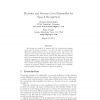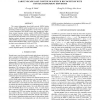ACL
2012
12 years 8 months ago
2012
We investigate the problem of acoustic modeling in which prior language-specific knowledge and transcribed data are unavailable. We present an unsupervised model that simultaneou...
ICA
2012
Springer
13 years 1 months ago
2012
Springer
Abstract. Missing data in corrupted audio recordings poses a challenging problem for audio signal processing. In this paper we present an approach that allows us to estimate missin...
CORR
2012
Springer
13 years 1 months ago
2012
Springer
Markov jump processes and continuous time Bayesian networks are important classes of continuous time dynamical systems. In this paper, we tackle the problem of inferring unobserve...
115
click to vote
Publication
This paper aims to address the problem of anomaly detection and discrimination in complex behaviours, where anomalies are subtle and difficult to detect owing to the complex tempor...
FGR
2011
IEEE
13 years 9 months ago
2011
IEEE
— In this paper we propose a method that exploits 3D motion-based features between frames of 3D facial geometry sequences for dynamic facial expression recognition. An expressive...
105
click to vote
EJASMP
2011
13 years 9 months ago
2011
We address the question of whether and how boosting and bagging can be used for speech recognition. In order to do this, we compare two different boosting schemes, one at the pho...
ICASSP
2011
IEEE
13 years 9 months ago
2011
IEEE
The context-independent deep belief network (DBN) hidden Markov model (HMM) hybrid architecture has recently achieved promising results for phone recognition. In this work, we pro...
ICASSP
2011
IEEE
13 years 9 months ago
2011
IEEE
We present a semi-supervised source separation methodology to denoise speech by modeling speech as one source and noise as the other source. We model speech using the recently pro...
TSP
2010
14 years 18 days ago
2010
We address the problem in signal classification applications, such as automatic speech recognition (ASR) systems that employ the hidden Markov model (HMM), that it is necessary to...
INTERSPEECH
2010
14 years 22 days ago
2010
It is generally known that a well-designed excitation produces high quality signals in hidden Markov model (HMM)-based speech synthesis systems. This paper proposes a novel techni...




